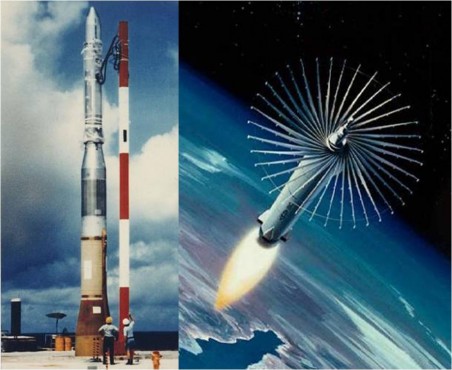Twenty-six years ago this month, the United States Army’s Homing Overlay Experiment (HOE) anti-missile successfully intercepted a ballistic missile target in space. The feat marked the first time in aerospace history that an exoatmospheric hit-to-kill intercept was achieved.
The HOE Program was a technology demonstration effort conducted by the United States Army (USA) to enable a nonnuclear hit-to-kill intercept capability for application against Soviet nuclear warheads. The Lockheed Company was awarded the development contract in 1978. A total of four (4) exoatmospheric flights tests were conducted from February 1983 through June 1984.
The HOE interceptor was unique in that it employed a 13-ft-diameter radial net that markedly increased the frontal area of the interceptor. The net mechanism was deployed just before target intercept. This unit consisted of 36 aluminum spokes, to each of which was affixed a trio of stainless steel weights or fragments.
The HOE test vehicle was equipped with an IR seeker for target detection in space. Upon target detection, the onboard propulsion system was driven by vehicle guidance and control to place the interceptor on a collision course with the target. At a closing velocity of 20,000 ft/sec, the kinetic energy of the 2,600-lb HOE interceptor was more than sufficient to destroy the target.
A two-stage Minuteman 1 Intercontinental Ballistic Missile (ICBM) served as the HOE booster. It was launched from Meck Island on the Kwajalein Missile Range out in the Marshall Islands. The target vehicle was also a Minuteman missile configured with a dummy warhead. It was launched from 4,500 miles away at Vandenberg Air Force Base, California.
The first three (3) HOE flight tests failed to produce a successful hit-to-kill intercept due to system detection and guidance anomalies. However, on Sunday, 10 June 1984, everything worked as planned when the fourth and final HOE test vehicle successfully intercepted and destroyed the ballistic target via kinetic kill. In the glow of the post-flight celebration, the successful HOE intercept was likened unto hitting a bullet with a bullet.
The HOE flight demonstration success came at a pivotal time in that the vaunted Strategic Defense Initiative (SDI) had begun in January of 1984. The importance of the first-ever hit-to-kill intercept was recognized in 1986 when the HOE Program received that year’s American Defense Technical Achievement Award.
The HOE concept never saw mass production since it was a heavy and rather expensive solution to the hit-to-kill problem. However, its technical legacy extends to the present day. Indeed, the highly capable and ever-evolving Aegis Ballistic Missile Defense (ABMD) system is a vital component of our nation’s Ballistic Missile Defense System (BMDS).

